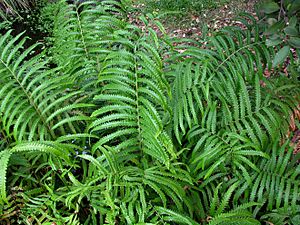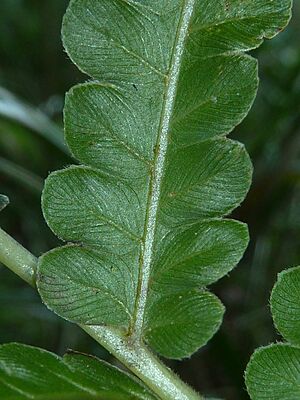Hottentot fern facts for kids
Quick facts for kids Hottentot fern |
|
|---|---|
 |
|
| Conservation status | |
| Scientific classification | |
| Genus: |
Cyclosorus
|
| Species: |
interruptus
|
| Synonyms | |
|
|
The Hottentot fern or swamp shield-fern (scientific name: Cyclosorus interruptus) is a type of fern. It belongs to the Thelypteridaceae family. This fern grows in warm, wet parts of the world. You can find it in many tropical and subtropical areas.
In the Americas, it lives from Mexico all the way to Argentina. It also grows on islands in the Antilles. In other parts of the world, it is found in countries like India, China, Malaysia, and South Africa. You can also see it in Australia, New Zealand, Hawaii, and other Pacific islands. Different groups of this fern can look a bit different. They might have slight changes in their genes, tiny glands, or how hairy their leaves are. The size of their leaves can also vary. This fern loves to grow near freshwater swamps. It can grow quite tall, sometimes reaching about 1 meter (3 feet) high.
History of the Hottentot Fern
In 1770, during Captain James Cook's first big trip, scientists collected this fern. Joseph Banks and Daniel Solander found it near Botany Bay in Australia. Even today, you can still find this fern in a park in Monterey, a suburb of Sydney. This is true even with all the buildings and cities around.
The fern's scientific name, interruptus, comes from Latin. It refers to the way its spore clusters, called sori, are arranged. These sori grow in zig-zag lines or V-shapes along the edges of the fern's leaves. A small, hairy cover protects them. This cover can be round or kidney-shaped.
This plant first appeared in science books in 1794. It was named Pteris interrupta by a German scientist named Carl Ludwig Willdenow. Later, in 1810, another scientist, Robert Brown, wrote about it. He called it Nephrodium propinquum. Over the years, scientists have studied this fern a lot. They have changed its name and discussed where it best fits in the plant family tree.
Growing This Fern
The Hottentot fern can be a good plant for gardens. It needs to stay wet and should not be in places where it gets frosty. If you live in a warm, damp area, it might grow well for you. Some people have also said that the underground stem, called a rhizome, can be eaten.



